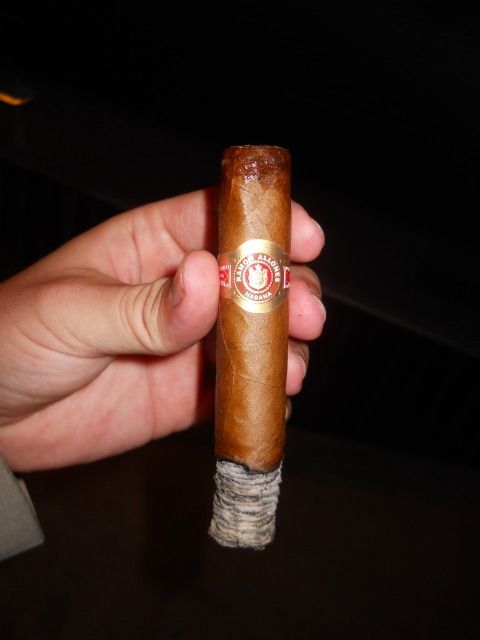This is my position - My opinions. This blog is a little bit of everything that I do and know that makes me what I am: A student and a soldier. A gentleman and a scholar. A writer, an investor, a businessman, and an adventurer.
Here I Stand

Tuesday, November 20, 2012
Why the World Depends on the United States
Monday, November 19, 2012
Bad Business Decision of the Day: Carl's Jr. CSU-Long Beach Student Union
Friday, September 28, 2012
Know your Suit!
 |
| Notched Lapel |
 |
| Peaked lapel |
Monday, September 3, 2012
Comisario Tequila Anejo
Berger & Argenti Mooch
Tuesday, August 28, 2012
Why Hiring a Veteran Could Be The Best Thing You do for Your Business.

Monday, August 27, 2012
Rocky Patel, The Edge, Maduro
Oliva Serie V, 6 x 56 Torpedo
Knob Creek Single Barrel: Kentucky Bourbon

Knob Creek Single Barrel Kentucky Bourbon
Tuesday, July 17, 2012
La Aroma de Cuba - Edicion Especial Robusto
Thursday, June 28, 2012
Fort Michilimackinac - Mackinac, MI
| Me with a Chippewa War Club |
| Archeologists explaining their dig site |
| Fur Trading Post at MichiliMackinac |
| British Grenadier |
| French Canadian Voyager at her camp outside the fort |
| The British 8th Regiment of Foot - Firing 3 rounds a minute |
| Interpreters representing Battalion Companies of the 8th |
| Cleaning the Brown Bess |
Saturday, June 23, 2012
Room 101 La Serie C – Connecticut Shade Torpedo
Friday, June 22, 2012
Oliver Wendell Holmes Mural
Found this mural while wandering around on my lunch break. It is on the back end of the Legacy Oceangate Towers and it caught my attention. I just thought it was pretty cool. Pictures were taken on my phone, so forgive the quality, but the Oliver Wendell Holmes quote was also quite appropriate - especially in the Business District of Long Beach.
Enjoy!
Wednesday, June 13, 2012
Wild Geese Irish Soldiers & Heroes - Rare Irish Whiskey
Friday, June 1, 2012
Ramon Allones Robusto
Monday, May 28, 2012
Memorial Day
Friday, May 18, 2012
Facebook IPO
Friday, May 11, 2012
Changes
There is a lot going on for me these days, with exams, drill, work and summer opportunities all coming to a head, so I have been a bit remiss in posting as of late. Rest assured that there are still thing's going on and you will hear about them shortly. I was a guest instructor at a tactical carbine course, I went to a couple of really great cigar events, our Charlie Sheen issue is coming out, and I have a few more reviews that I'm going over as well. You will get the details on all of it soon.
You will also start seeing changes to the format and tone of my articles. Also some changes in the setup, template, and color scheme. Less militaristic, less of a rant. More informative. I hope the change will be for the better as I am looking for that last push to get me over 30K hits.
Also, if anyone who reads this has anything that they would like to read about or get some insight on, please feel free to leave a comment and I will try to help out. Fashion, finance, business, cigars, liquor, weapons, tactics, culture, even politics to some extent.
Well, I am writing this via Blogger fr android on my phone, while sitting onva bus on my way up to Camp San Luis Obispo for drill, so I will wrap this latest entry up, but not before I try and upload a photo via my mobile device. That's a button down spread collar from Hugo Boss. Enjoy!
Tuesday, May 1, 2012
May Day!
Happy May Day everyone! Oh, you don't celebrate May Day? Good for you! That's likely because you're not a disillusioned ,ignorant, communist hippie, and I applaud your decision to be a productive member of society!
If you do celebrate May Day, then that is your choice, and a right guaranteed to you by the US Constitution, the very concept you wish to supplant, and the document that I and my brothers and sisters in arms have fought to uphold and defend. I don't agree with what you have to say, but I will defend your right to say it!
So don't forget to wear red and have a parade no one cares about, because seriously, no beads or moonpies? What was Stalin thinking?
Friday, April 27, 2012
Fashionable Concealed Carry
The most frustrating comment of all though, appears to be the very last. The gun owner, who works in a gun store, declares that you should dress around your gun, not to fashion. I find this idea absurd.You ought to be able to do both. Neither side in this argument seems to be able to find a middle ground - and for the "everyday man" who wears work pants and a vest around town, you're not fooling anyone. You're carrying, and anyone who matters knows it. Whats worse, is that you look like a tool, and you orient your entire life around that .45 on your hip. I look good when I carry (when I find myself in a state that allows me to) and there is more than one way to print a gun. You can do it in your style, and demeanor - which does not always deter criminals, just everyone else in your life.
Original Link: http://www.cnbc.com/id/47158181/
New Fashion Wrinkle: Stylishly Hiding the Gun
By: Matt Richtel
Woolrich, a 182-year-old clothing company, describes its new chino pants as an elegant and sturdy fashion statement, with a clean profile and fabric that provides comfort and flexibility.
 0.57 (+1.14%)
0.57 (+1.14%)
 -2.11 (-5.17%)
-2.11 (-5.17%)
 0.93 (+0.96%)
0.93 (+0.96%) 










